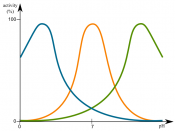Introduction
The purpose of this experiment was to observe how changes in pH temperature, substrate concentration, and enzyme concentration affect the enzymatic activity of catecholase. Catecholase is an enzyme contained in some fruits and vegetables. The brown color of fruits and vegetables is the reaction of catecholase when exposed to oxygen (Helms). The reacting molecule in an enzymatic reaction is called a substrate. Another purpose of this experiment is to determine the maximum velocity and substrate concentration for the reaction of -amylase and starch. The substrate (starch) and the enzyme ( - amylase) come together for a short time and then break down to yield the products and enzyme. Once the enzyme configuration is altered in the reaction it is useless and becomes decomposed in the normal course of cellular metabolism. The rate of the enzymatic reaction, needed for figures three and four, is set by the rate at which the enzyme-substrate complex forms and then decomposes to form the product.
The amount of time it takes the enzyme to effect the substrate and the frequency at which the complex (enzyme-substrate) forms. The frequency depends greatly on the concentration of the substrate. As the reaction proceeds and starch is turned into the product by the enzyme, the chances of the enzyme encountering a starch molecule becomes less and so the reaction rate decreases. Most starch is converted at the initial stage of the reaction and therefore the maximum reaction rate is highest at this stage in the reaction. From a resulting curve from of the enzymatic reaction, showing disappearance of substrate over time, the maximum velocity at which that particular reaction occurs and the concentration of the substrate at which Vmax/2 occurs can be determined (Campbell). Although substrate concentration is important in determining the rate of the reaction, it is...



An advice
Include a source of error/uncertainty and consderation for the credability of the experiment. Relate the hypothesis to the intro wth justification of your hypothesis. and in my experience use If-Then statment is better.
1 out of 3 people found this comment useful.